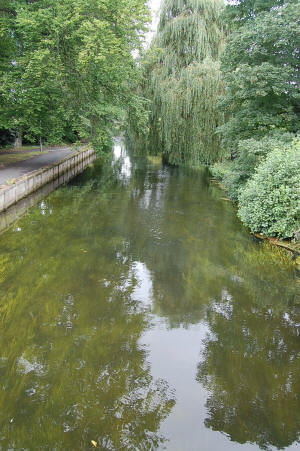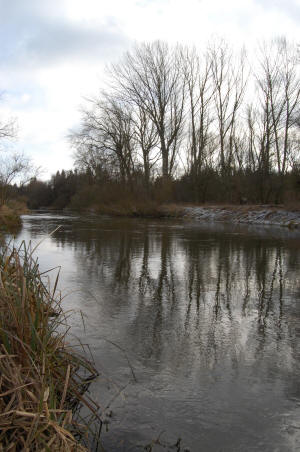River Little Ouse
|
| The River Little Ouse rises (like the
River Waveney) at
South Lopham Fen. From here it flows westwards forming
the border between Norfolk and Suffolk.

The Little Ouse,
Thetford
It flows close
to Blo' Norton Hall, the
moated Elizabethan house, which Virginia Woolf visited
in 1906 and which provided inspiration for her short
story The Journal of Mistress Joan Martyn. While
staying at the hall she kept a journal of her own in
which she mentions the river:
|
| 'The river, the
Little Ouse deserves its diminutive; you may leap it -
fall in as I did this afternoon - but all the same it is
not a hazardous jump. You are sure of the mud at any
rate. And there radiate various minor tributaries,
ditches I should call them, did not I know of their
relationship with the river.....' |
|
Just south of Thetford the
Little Ouse is joined by the Black Bourn which flows
northwards through Suffolk. Then, in the centre of
Thetford at Butten Island, it is joined by the River
Thet.
George Bloomfield, the brother of Robert Bloomfield
(author of The Farmer's Boy) wrote a poem about
Thetford which mentions the Little Ouse:
|
Thy sloping hills and wooded vallies
gay,
Whose silv'ry Ouse meand'ring winds his
way. |
Just to the west of the town, the river enters the vast
plantations of Thetford Forest and winds its way to
Santon Downham. Roger Deakin, the author of Waterlog,
went wild-swimming here. His book was inspired by
John Cheever's classic short story The Swimmer
and is a record of his wild-swimming exploits across the
UK.

A wintry Little Ouse at
Santon Downham
Tragically Deakin died from a brain tumour at the
age of 63 just when he was at the height of his creative
powers. In 2007, he published a superb follow-up to
Waterlog entitled Wildwood - which was an account
of his relationship with trees. However, here is his
wonderful description of the Little Ouse:
|
|
'The Little Ouse is a wadi running through the Breckland
desert. It comes as a surprise to find a river of such
beauty in this arid, sandy place, like coming over a
barren ridge and seeing the lush palm groves of the Draa
Valley of Marrakesh. In the neolithic days when the
whole area was a populous centre of industrial
flint-mining, the river must have been a busy place.' |
After Santon the Little Ouse flows through the town of
Brandon which lies close to Weeting. Weeting has two literary
connections: it was the birthplace of the poet Thomas
Shadwell who had a famous war of words with John Dryden
and Weeting Castle is where Hereward the Wake fooled the
Norman king in Charles Kingsley's story.Beyond
Lakenheath the Little Ouse eventually merges with the
River Great Ouse at Brandon Creek.
|
Links:
The Little Ouse
Headwaters Project |

